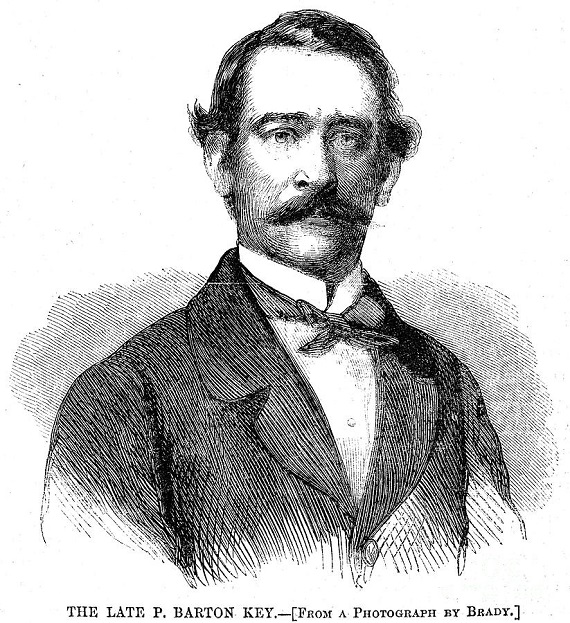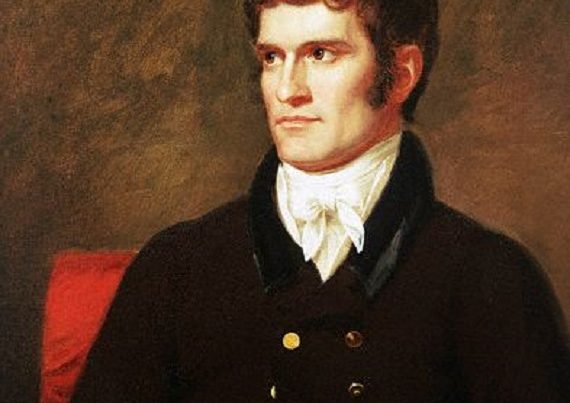In our time, we think we know a lot about presidential cover-ups. There was Nixon’s Watergate, of course. Some of us remember Lyndon Johnson’s problems with Bobby Baker. And President Kennedy had his secret girlfriends.
All of these, however, are minor matters compared to the granddaddy of them all, the biggest presidential cover-up in American history, the murder of Barton Key (son of Francis Scott Key of “National Anthem” fame). A complicated tale, it all began in the years before our Great War, in the heat of controversy, during the public life of old Dan Sickles.
Before James Buchanan became president in 1857, he was Minister to England under President Pierce. During that time, Buchanan asked Pierce to appoint Daniel Sickles of New York to be the Minister’s Secretary.
Sickles, a young lawyer, had begun his political career in the Wigwam of Tammany Hall and had advanced to the position of Counsel for the port of New York. Pierce’s Secretary of State, William Marcy, also of New York, refused to sign Sickles commission. Marcy was aghast that a man such as Sickles, a Tammany Hall brawler, who had flouted his prostitute in the halls of the statehouse, should be appointed to such a sensitive position. Buchanan insisted, however, referring to Sickles as a “brilliant lawyer, politician, and man of the world, who had a host of friends, and not a few enemies, like all men of force and originality.” When Marcy, who had been Governor of New York and knew Sickles well, still refused, President Pierce had Assistant Secretary of State Dudley Mann sign the commission.
Sickles and Buchanan sailed for England in 1853. Age 34, Sickles left his 17-year-old pregnant wife Teresa at home and took along Fanny White of dubious reputation, who reportedly ran a house of ill repute on Mercer Street in New York. In due course, Sickles presented Miss White to Queen Victoria at one of her drawing room receptions.
Later, when James Buchanan was inaugurated as the fifteenth President of the United States in 1857, he brought with him to Washington Tammany Hall’s newest congressman, the same Daniel Sickles–now closest confidant to the President, the man who handled all presidential appointments and became, next to Buchanan, the most powerful man in Washington.
On arriving in Washington, Dan Sickles quickly established his power base and his social base. Washington was then a Southern city, and Sickles, with his beautiful wife Teresa, moved into an elegant home overlooking Lafayette Square, the neighborhood of many prominent Southern leaders, among them Barton Key, whom Mrs. Clay in her book A Belle of the Fifties called “the handsomest man in all Washington society.”
Barton Key had come from old Southern wealth and prominence. His uncle, Chief Justice Taney, had sworn in eight presidents during his stay on the Supreme Court. His poetical father had watched the rockets over Fort McHenry and gave us our “National Anthem.” Francis Scott Key had also been Federal District Attorney of the District of Columbia, to which post his son Barton had been appointed during the Pierce presidency. Now, with a new administration, Barton Key sought reappointment to this political plum. To do so, he had to seek out Dan Sickles.
In 1856 Key had been criticized for his failure to convict Congressman Herbert of California, who had shot and killed an insolent waiter at Willard’s Hotel. Key, it seems, had not been very active in the prosecution. This oversight apparently did not trouble Sickles, who became fast friends with Barton Key and had him reappointed.
In those early days in Washington, many Congressional committees met at night and, like today, there were numerous social affairs throughout the week. Balancing social and political responsibilities required a flexible schedule and it was not uncommon for members of the government detained by the business of state to ask friends to escort their wives to social affairs. In this manner, Barton Key became the constant escort of Teresa Sickles, the wife of his good friend Dan.
What began as an escort service, turned into a torrid love affair. Soon everyone in Washington knew what was going on. Everyone except Dan Sickles.
Key rented a small brick house at 383 Fifteenth Street, two blocks from the Sickles home, for clandestine meetings. At least, the two lovers thought it secret. But neighbors watched Key as he walked through the park in front of the Sickles home and made a rotary signal with a white hankerchief, then pulled out his field glasses and watched Teresa’s window for her signal. When he got a positive answer, he would proceed to the Fifteenth Street house where he would hang a red ribbon on the shutter, much to the amusement of the residents of this back street who watched through their shutters as Teresa came out of her back door, covered her face with a shawl, and proceeded to 383 Fifteenth where she would stay for an hour or so with Barton Key.
In late February of 1859, things came to a head when Sickles received an unsigned letter detailing his wife’s and Barton Key’s behavior. In a rage he demanded and got a written confession from Teresa, a remarkable document that even went into the details of undressing. Beside himself with rage and grief, he took Teresa’s wedding band, made her sleep on the floor that night, and called in his New York friends to decide what to do.
This was a crucial decision, for Daniel Sickles had his eye on the presidency. After all, the last two presidents had been his friends and he had had a large part in putting them both in office. In 1859, he was known to be a national leader in Democrat party politics, at the right hand of the President in all matters. The Barton Key-Teresa Sickles affair loomed as a dark cloud over his political life, and as he sat with his friends in his study overlooking the park, wondering how many people in Washington knew, there suddenly appeared Barton Key. There he was in the park waving his handkerchief in a rotary motion, then looking at the upstairs bedroom window with his field glasses. In a blind rage, Dan Sickles grabbed a pistol, rushed into the park, and shot Key in the groin. Then he dispatched him to eternity with a second shot as Key lay on the ground begging for mercy.
A White House page, J.H.W. Baritz of North Carolina happened to be walking by at the time and witnessed the shooting. He immediately rushed over to the White House and informed the President. President Buchanan, took money out of his own pocket and sent the witness back to North Carolina that day with the warning that he might be put in jail if he did not get away quickly.
Apparently on principle, Sickles refused bail and went to jail. An artist’s picture of the congressman languishing in prison generated a great deal of sympathy, and all of his friends came to see him. Speaker of the House James L. Orr of South Carolina, a good friend, visited and had him moved from a dank cell to the jailor’s quarters. During a speedy trial, Sickles was defended by eight leading attorneys led by the able and fiery Edwin M. Stanton, a close friend of both Sickles and the President. Stanton was appointed the very next year as Attorney General of the United States. This is the same Stanton who later served both Lincoln and Andrew Johnson as Secretary of War, and who precipitated Johnson’s impeachment trial.
The prosecutor was Robert Ould, who had been Key’s assistant and who the President promptly appointed to the office of District Attorney. For some reason, Ould seemed not to have his heart in the prosecution and the eloquent defense attorneys swept him aside with a plea of temporary insanity, which was the first time that plea was used in American judicial history.
Upon Sickles acquittal, Stanton danced a jig in court and called for three cheers, which he got. A great party in Washington followed and thousands cheered Dan Sickles. These same friends and thousands more turned on the congressman just as lustily when in less than three months he took back the shamed Teresa.
Such was the controversial life of Daniel Sickles. But that was merely the beginning. He was re-elected in the next election by the Tammany Democrats and supported the South in general up until Fort Sumter. In 1860 he promised that no troops from New York City would ever make war against any state, but he eventually became a general in the Union Army at Gettysburg, where he lost a leg. Sickles either won the battle or nearly lost the entire war (depending on whose analysis you read; the argument on this still gets hot sometimes). However, President Lincoln congratulated him on his performance.
Following the war, Sickles was Military Governor of South Carolina while his old buddy of Washington days, James L. Orr, was governor of the state. At Orr’s request, Sickles gave an order which prohibited banks from foreclosing mortgages on Confederate widows. This incensed the judiciary, and they appealed to President Johnson, who directed his Secretary of War Edwin Stanton to countermand Sickles’ directive. Stanton and Sickles were old buddies from courtroom days and before, so Stanton was not about to do as the President directed. This led to Stanton being fired, which in part eventually led to Johnson’s impeachment.
Sickles went back to New York and was again elected to Congress, where he became a crony of President Grant, who eventually appointed him to be Ambassador to Spain. As a grey-headed, one-legged ambassador, he seduced the Queen of Spain and provoked a revolution in that country. But that’s another story in the life of Dan Sickles, which extended on until 1914, when the old man died with a head full of exotic memories at the ripe age of 95.
This piece was originally published in Southern Partisan in 1983.








This guy is actually one of my ancestors (on my mother’s side). I’m not really sure what to do with this information.